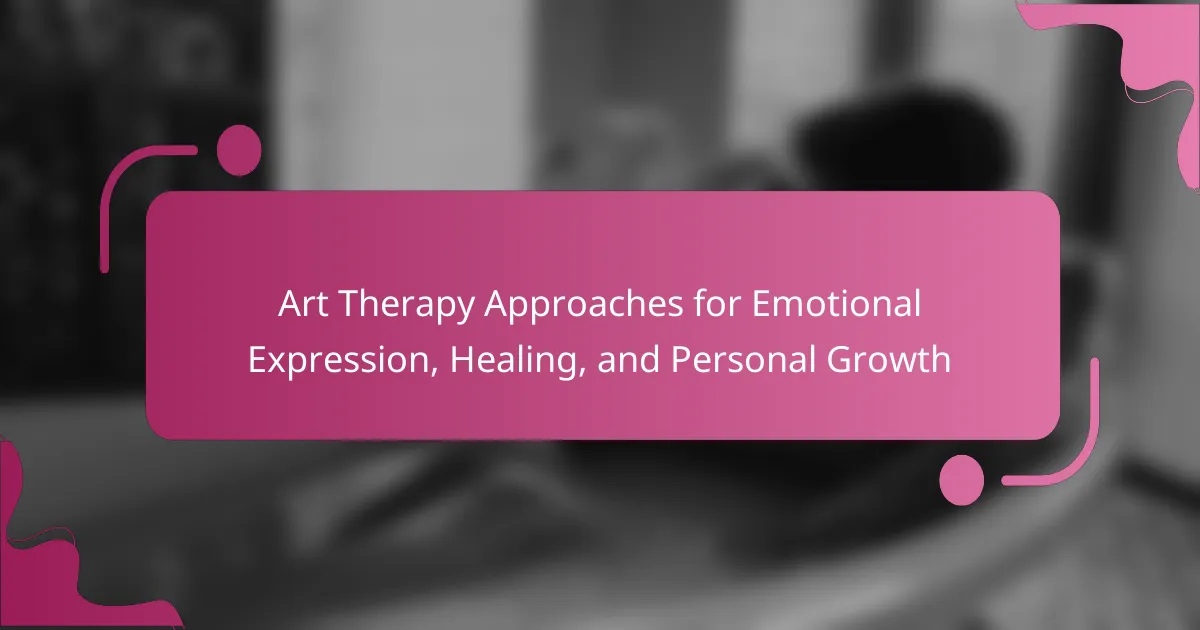Art therapy offers a powerful means for emotional expression, healing, and personal growth. This article explores various art therapy approaches, including drawing, painting, and digital art therapy, that enhance self-awareness and emotional regulation. It also discusses the unique benefits for diverse populations, such as children and individuals with trauma, while addressing challenges like accessibility and stigma. Finally, innovative techniques and best practices for creating a supportive environment in art therapy will be highlighted.
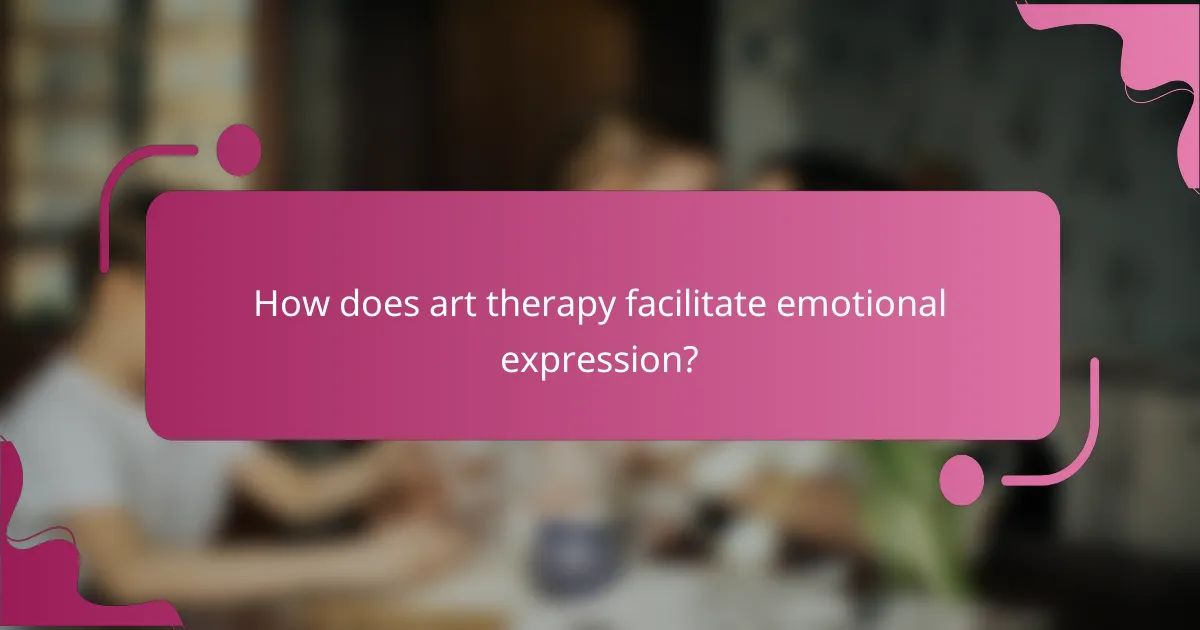
How does art therapy facilitate emotional expression?
Art therapy facilitates emotional expression by providing a creative outlet for individuals to communicate feelings and experiences. This approach encourages self-discovery and healing through various artistic mediums, allowing participants to explore emotions that may be difficult to articulate verbally.
Art therapy utilises techniques such as drawing, painting, and sculpture to promote personal growth. Engaging in these activities can lead to increased self-awareness and emotional regulation. Research indicates that art therapy significantly reduces symptoms of anxiety and depression, enhancing overall well-being.
Moreover, the unique attribute of art therapy lies in its ability to create a safe space for vulnerability. Participants often experience catharsis as they visualise and externalise their emotions, leading to transformative insights. This process fosters resilience and encourages healthier coping mechanisms.
In summary, art therapy serves as a powerful tool for emotional expression, healing, and personal growth by harnessing creativity to navigate complex feelings and experiences.
What techniques are commonly used in art therapy for emotional release?
Art therapy commonly employs techniques such as painting, drawing, sculpting, and collage to facilitate emotional release. These methods allow individuals to express feelings non-verbally, promoting healing and personal growth. Creative expression can lead to insights and self-discovery, enhancing emotional well-being. Techniques may include guided imagery, where clients visualise scenes that evoke emotions, and art-making in a group setting, fostering connection and support.
How do different art materials influence emotional outcomes?
Different art materials significantly influence emotional outcomes in art therapy. Various materials evoke distinct feelings and facilitate different modes of expression. For example, vibrant colours can stimulate joy and energy, while softer tones may promote calmness and reflection. Textured materials can encourage tactile engagement, enhancing emotional release. The choice of medium, whether paint, clay, or collage, shapes the therapeutic experience, allowing individuals to explore and articulate their emotions uniquely. This interplay between materials and emotional expression fosters personal growth and healing in therapy settings.
Why is non-verbal communication significant in art therapy?
Non-verbal communication is significant in art therapy because it allows individuals to express emotions that words cannot capture. This form of expression fosters deeper connections between the therapist and the client. Non-verbal cues, such as body language and artistic choices, provide insights into a person’s feelings and experiences. As a result, art therapy can facilitate healing and personal growth by addressing emotional issues in a unique and impactful way.
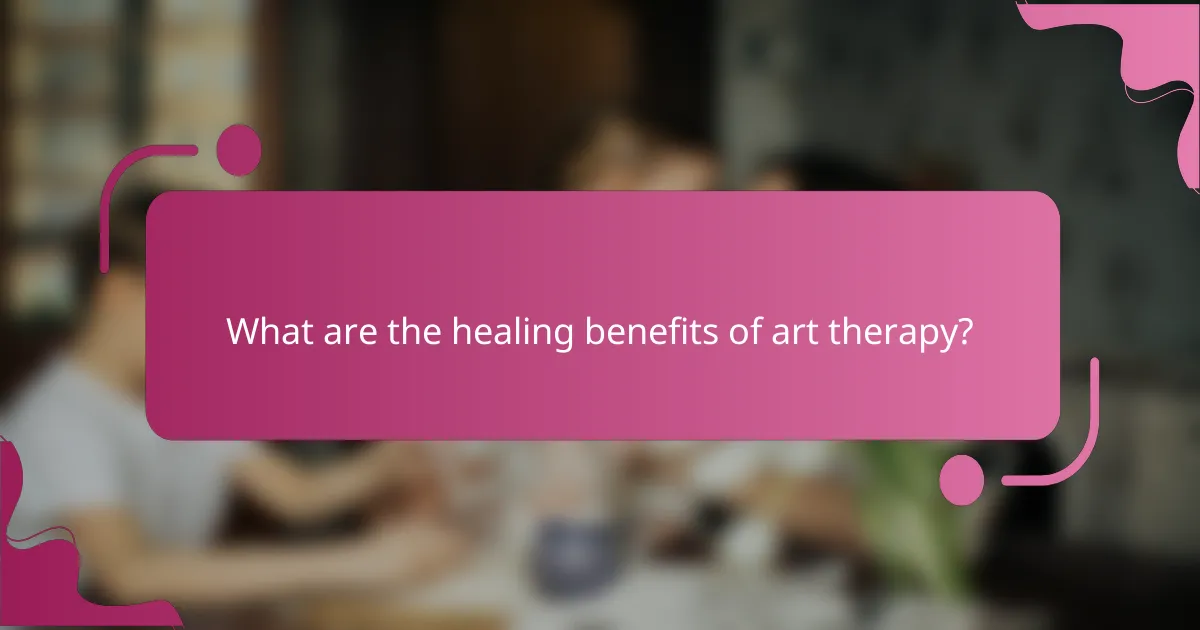
What are the healing benefits of art therapy?
Art therapy promotes emotional expression, healing, and personal growth through creative processes. It enhances self-awareness, reduces anxiety, and fosters resilience. Participants often experience improved communication skills and emotional regulation. Art therapy uniquely allows individuals to express feelings that may be difficult to articulate verbally, providing a safe space for exploration. Research indicates that engaging in art therapy can lead to significant reductions in symptoms of depression and trauma-related stress.
How does art therapy support trauma recovery?
Art therapy supports trauma recovery by facilitating emotional expression and personal growth. It provides a safe space for individuals to explore their feelings through creative processes. This non-verbal form of communication can help individuals articulate experiences that are difficult to express verbally.
Art therapy techniques, such as painting or sculpting, can promote healing by allowing clients to externalise their trauma. Engaging in these activities can reduce anxiety and improve mood. Studies show that art therapy reduces symptoms of PTSD, enhancing emotional resilience.
Additionally, art therapy fosters personal growth by encouraging self-reflection and insight. Clients can gain a better understanding of their emotions and develop coping strategies. This approach not only aids in recovery but also empowers individuals to rebuild their lives.
In summary, art therapy is an effective tool for trauma recovery, promoting emotional expression, healing, and personal development.
What role does art therapy play in mental health treatment?
Art therapy plays a crucial role in mental health treatment by facilitating emotional expression and promoting healing. It utilises creative processes to help individuals explore their feelings and experiences. This approach enhances self-awareness and fosters personal growth. Research indicates that art therapy can reduce symptoms of anxiety and depression, providing a unique outlet for communication. The hands-on nature of art-making can also lead to improved coping strategies and resilience. Overall, art therapy serves as a valuable tool in a comprehensive mental health treatment plan.
How can art therapy enhance self-esteem and confidence?
Art therapy can significantly enhance self-esteem and confidence through creative expression and personal exploration. Participants engage in artistic activities that promote self-discovery, allowing them to express emotions and thoughts that may be difficult to articulate. This process fosters a sense of accomplishment and validation, reinforcing positive self-perception.
Art therapy approaches often include techniques such as painting, drawing, and collage-making, which help individuals explore their feelings in a safe environment. As a result, clients can develop a stronger sense of identity and self-worth. Studies indicate that engaging in art therapy can lead to improved emotional regulation and resilience, further boosting self-esteem.
The unique attribute of art therapy lies in its ability to facilitate non-verbal communication. This aspect allows individuals to express complex emotions visually, leading to breakthroughs in self-understanding. Additionally, the collaborative nature of art therapy can create supportive relationships, enhancing social confidence.
In conclusion, art therapy serves as a powerful tool for personal growth, enabling individuals to build self-esteem and confidence through creative expression and emotional healing.
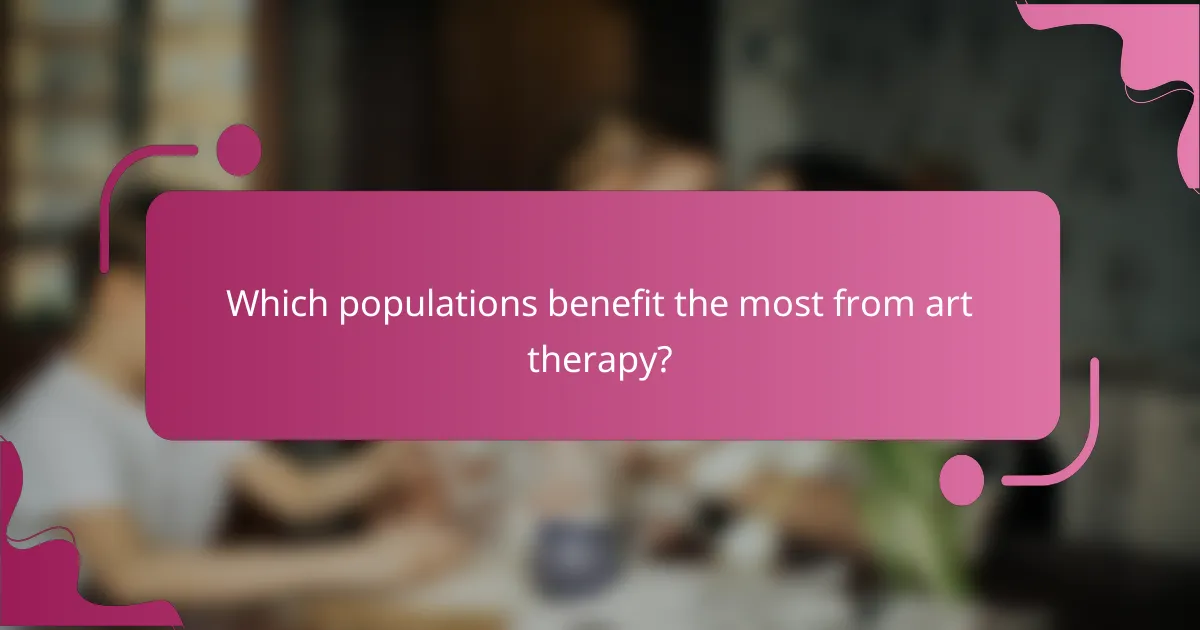
Which populations benefit the most from art therapy?
Populations benefiting the most from art therapy include children, individuals with trauma, the elderly, and those with mental health disorders. Art therapy fosters emotional expression and healing through creative outlets.
Children often use art therapy to process feelings and enhance communication skills. Individuals with trauma find it a safe space to explore difficult emotions. The elderly benefit from art therapy by improving cognitive function and reducing feelings of isolation. Those with mental health disorders, such as anxiety or depression, can express themselves creatively, facilitating personal growth and healing.
How is art therapy adapted for children and adolescents?
Art therapy is adapted for children and adolescents through tailored approaches that foster emotional expression and personal growth. Techniques include using age-appropriate materials, integrating play, and focusing on themes relevant to their experiences.
Children often benefit from structured activities that allow them to express feelings non-verbally. Adolescents may engage in more complex projects that encourage self-reflection. Group sessions can provide social support, enhancing the therapeutic experience.
Art therapy also incorporates unique attributes like cultural relevance, ensuring the activities resonate with the child’s background. This adaptation promotes healing by making the process relatable and engaging.
Flexibility in methods allows therapists to respond to individual needs, ensuring that each session is effective in promoting emotional well-being. The goal is to create a safe space for exploration and expression, crucial for developmental stages.
What are the unique considerations for older adults in art therapy?
Older adults in art therapy require tailored approaches to address their unique emotional and cognitive needs. These considerations include accessibility of materials, the importance of social interaction, and the therapeutic benefits of reminiscing through art.
Art therapy can enhance emotional expression by allowing older adults to explore their feelings about aging, loss, and identity. Group settings foster social connections, reducing feelings of isolation. Additionally, art-making can stimulate cognitive function, promoting mental agility and creativity.
Therapists should also consider physical limitations, ensuring that tools and mediums are suitable for varying dexterity levels. Personalisation of themes and techniques can enhance engagement and foster a sense of accomplishment.
Incorporating familiar subjects or memories into art projects can evoke positive emotions and facilitate healing. Overall, art therapy serves as a powerful tool for emotional expression, healing, and personal growth in older adults.
How does cultural background influence the effectiveness of art therapy?
Cultural background significantly influences the effectiveness of art therapy by shaping individual expression and interpretation. Diverse cultural perspectives affect how emotions are conveyed through art, impacting therapeutic outcomes. For instance, certain cultures may prioritise collective expression, while others focus on individual experiences. This difference can alter the therapeutic process, making it essential for therapists to understand a client’s cultural context. Cultural relevance in art therapy can enhance engagement and promote healing, as clients resonate more with culturally familiar symbols and practices. Understanding these dynamics fosters a more personalised and effective therapeutic experience.
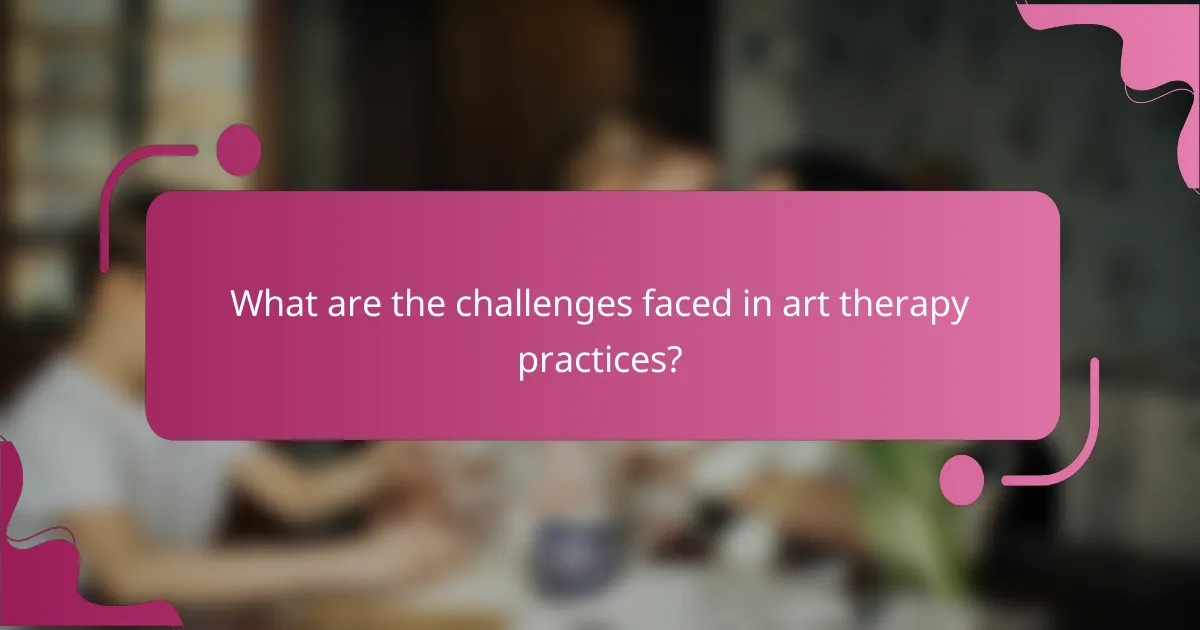
What are the challenges faced in art therapy practices?
Art therapy faces several challenges that can impact its effectiveness. Limited access to trained professionals restricts availability for those in need. Stigma surrounding mental health can deter individuals from seeking help through art therapy. Additionally, varying levels of artistic ability may affect participants’ comfort and engagement. Inconsistent funding and resources can hinder program sustainability. Lastly, the subjective nature of art interpretation may lead to misunderstandings in therapeutic contexts.
How can therapists overcome resistance to art therapy?
Therapists can overcome resistance to art therapy by creating a safe and trusting environment. Building rapport encourages clients to express themselves freely. Utilising diverse art materials can help engage clients and reduce anxiety. Incorporating guided prompts can facilitate deeper exploration of emotions. Lastly, being patient and flexible in approach allows clients to progress at their own pace.
What are the common misconceptions about art therapy?
Many believe art therapy is solely about creating art, but it encompasses emotional expression, healing, and personal growth through various approaches. Common misconceptions include the idea that participants need artistic talent, that art therapy is only for children, and that it is a quick fix for mental health issues. Additionally, some think it lacks scientific validity, while others may view it as merely art classes rather than a therapeutic process. Understanding these misconceptions can enhance the appreciation of art therapy’s benefits.
How do therapists measure the success of art therapy interventions?
Therapists measure the success of art therapy interventions through client feedback, progress assessments, and behavioural changes. They utilise standardised tools to evaluate emotional expression and personal growth.
Progress is often tracked using qualitative and quantitative metrics. Clients may complete surveys or journals that reflect their emotional states before and after sessions. Behavioural observations during sessions also provide insights into changes in emotional regulation.
Another method involves setting specific, measurable goals at the beginning of therapy. These goals can include improved coping skills or enhanced self-awareness. Therapists analyse the extent to which clients meet these objectives over time.
Lastly, therapists may incorporate follow-up sessions to assess long-term effects. This ongoing evaluation helps to ensure that art therapy continues to support emotional healing and personal development effectively.
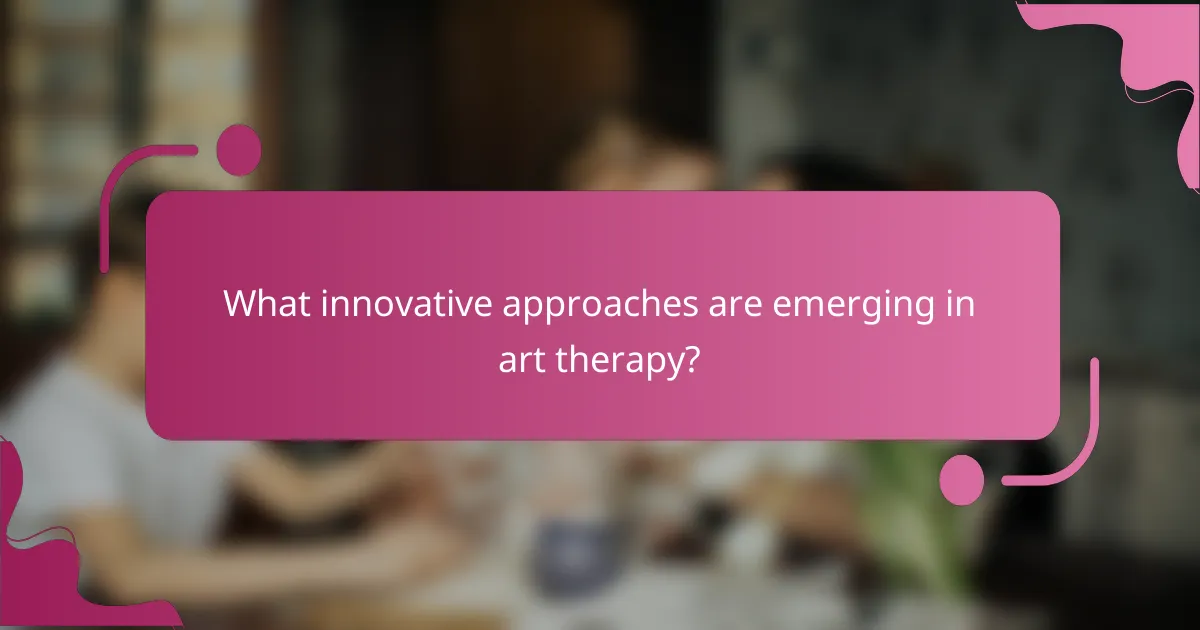
What innovative approaches are emerging in art therapy?
Innovative approaches in art therapy focus on enhancing emotional expression, healing, and personal growth. Techniques like digital art therapy utilise technology to create interactive experiences. Expressive arts therapy combines various art forms, allowing clients to explore emotions through multiple mediums. Mindfulness-based art therapy integrates mindfulness practices, promoting presence and self-awareness during creative processes. Group art therapy fosters community and shared experiences, enhancing social connections. Each approach offers unique attributes, catering to diverse needs in emotional healing and personal development.
How is technology being integrated into art therapy sessions?
Technology enhances art therapy by incorporating digital tools, virtual reality, and online platforms. These innovations facilitate emotional expression and personal growth in therapeutic settings. For instance, virtual reality can create immersive environments that help clients explore emotions safely. Digital art applications allow for immediate feedback and experimentation, fostering creativity. Online sessions expand access, making therapy available to those who may not attend in person. Integrating technology into art therapy sessions promotes engagement and adaptability, ultimately enriching the healing process.
What are the unique attributes of community-based art therapy programs?
Community-based art therapy programs uniquely foster collaboration, inclusivity, and cultural expression. They often integrate local art forms, enhancing emotional connection and community identity. These programs utilise diverse mediums, such as painting, sculpture, and performance, to facilitate healing and personal growth. Additionally, they provide a supportive environment, encouraging participants to share experiences and build relationships.
How do art therapy retreats differ from traditional therapy settings?
Art therapy retreats emphasise creative expression and group dynamics, differing from traditional therapy’s structured dialogue. Retreats foster immersive environments, allowing participants to explore emotions through artistic mediums. This setting enhances personal growth by promoting community support and shared experiences, often leading to deeper connections and insights. Traditional therapy typically focuses on verbal communication, which may not suit everyone. Art therapy retreats provide a unique space for healing that caters to diverse emotional needs.
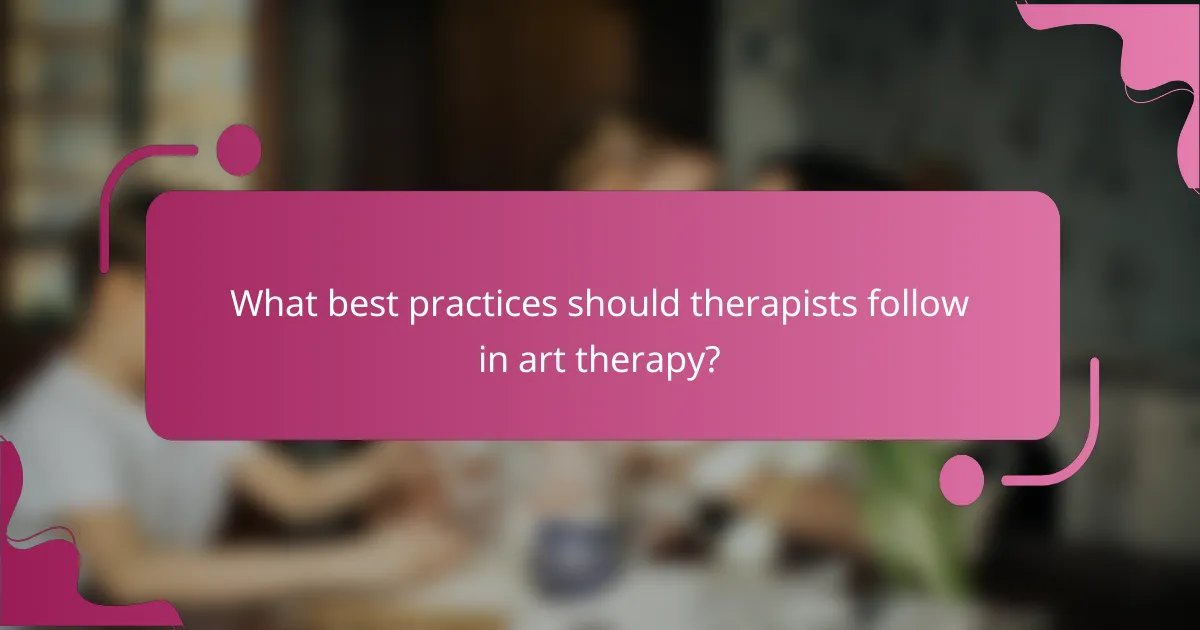
What best practices should therapists follow in art therapy?
Therapists should prioritise creating a safe, non-judgmental space in art therapy. This fosters trust and encourages emotional expression. Incorporating diverse art materials can enhance creativity and engagement. Regularly reflecting on the artistic process helps clients gain insights into their emotions and experiences. Lastly, therapists should continuously seek professional development to refine their skills and adapt to clients’ needs.
How can therapists create a safe space for clients in art therapy?
Therapists can create a safe space for clients in art therapy by fostering trust and openness. Establishing clear boundaries enhances comfort and encourages expression. Utilising empathetic listening allows clients to feel heard and validated. Providing diverse materials can inspire creativity and exploration. Regularly checking in on clients’ emotional states ensures their needs are met throughout the process.
What are the most effective ways to evaluate client progress in art therapy?
The most effective ways to evaluate client progress in art therapy include ongoing assessments, goal tracking, and reflective discussions. Regularly reviewing artwork allows therapists to gauge emotional shifts and personal growth. Utilising standardised evaluation tools enhances objectivity in measuring progress. Feedback from clients fosters a collaborative environment, encouraging deeper insights into their therapeutic journey.
How can art therapists continue their professional development?
Art therapists can continue their professional development through various methods. Engaging in workshops enhances skills and introduces new techniques. Networking with peers fosters collaboration and knowledge exchange. Pursuing certifications in specialised areas deepens expertise and expands practice scope. Regularly attending conferences keeps therapists updated on research and trends. Lastly, self-reflection and supervision provide essential insights for personal growth and emotional resilience.
